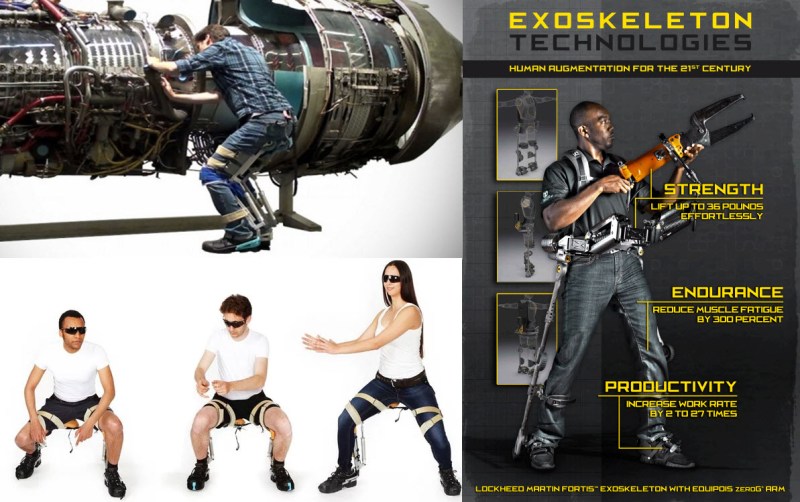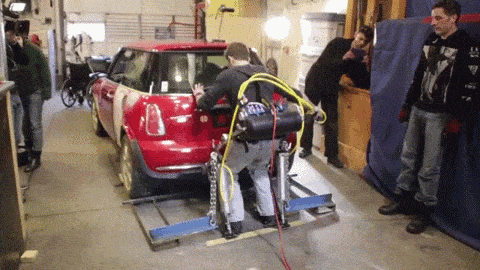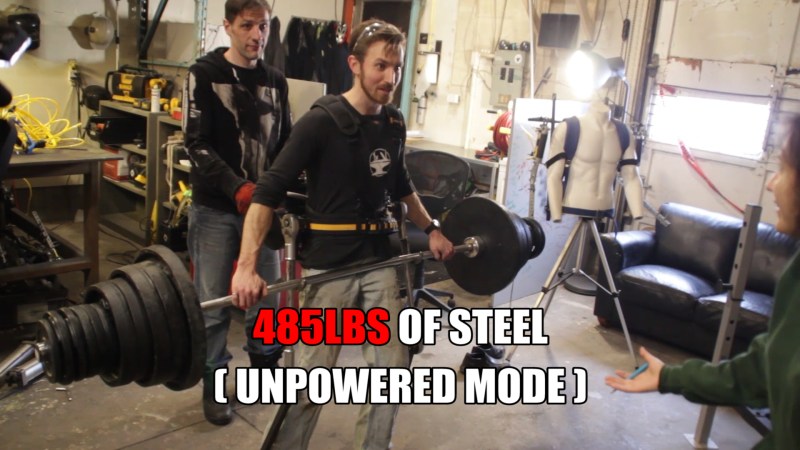As some of you may or may not know, I’m interested in everything exoskeleton related. I’ve been messing around with my own designs for the past year or so, and just this past weekend, tested out the latest lower body design. There are a lot of boring (and some would say safe) ways to test this. But that’s no fun. For my test I used the lower-half of the exoskeleton to pick up a Mini Cooper.
 You might remember my original upper-body design which was something I threw together in my garage as a proof of concept. It worked well for what it was, and surprisingly, took the internet by storm — amassing over a million views in a single week for a video of me curling 170lbs in my backyard. The fire had started — I knew I had to make something better. And that was the beginning of my quest to build a full-body powered exoskeleton.
You might remember my original upper-body design which was something I threw together in my garage as a proof of concept. It worked well for what it was, and surprisingly, took the internet by storm — amassing over a million views in a single week for a video of me curling 170lbs in my backyard. The fire had started — I knew I had to make something better. And that was the beginning of my quest to build a full-body powered exoskeleton.
The biggest problem with the original was a lack of back support — it didn’t matter how much weight I could lift, it was still my feeble human skeleton taking the weight. So it was time to go back to the drawing board, and start the design from the ground up.
Living the Dream
The project had been slow going with my time being taken up by pesky work, until just before Christmas when I decided to quit my full-time job as a Product Developer (I’m a mech engineer) and focus on exoskeletons, YouTube, and effectively become a “Hacker for Hire” — more on that in a future post!
Shortly after that, the German Science show Galileo reached out and asked if they could feature my new exoskeleton on their show — I agreed, and may or may not have promised them a feat of strength I wasn’t even sure I’d be capable of doing — lifting a car.
Like most engineers, I work best under pressure, so with less than a week to go before the interview, we started working on the legs. Getting the strength to lift a car was quite easy. I had a pair of 63mm bore diameter pneumatic cylinders, which at 125PSI are capable of lifting over 800lbs a piece. The fun part was attaching them to my body in order to do it.
Now truth-be-told, the cylinder mounts are not that elegant. Which is why I’m designing the exoskeleton to be completely modular — you can just remove the cylinders when you don’t need them — because you’re never going to be able to run with giant pneumatics like that. Not to mention we don’t possess arc reactor technology required to power an exoskeleton for any reasonable length of time…
Don’t Worry, They Lock
No, no, the real genius (if I do say so myself), is in the mechanical legs behind the cylinders. The locking joints that are able to take huge amounts of force.
Ratcheting joints on the exoskeleton allow me to take weight without any pressure or force going through my body. In the above test, we ran out of weights to put on the bar. The joints allow the exoskeleton to be flexible in free-float mode, which means I can even run with them — but provide amazing support and rigidity when required in locked mode.
Similar to the “chair-less chair”, exoskeleton legs like these could allow workers to work in awkward positions without straining their bodies. Or for a full-body solution, how about Lockheed Martin’s FORTIS exoskeleton?

While advancing battery technology will expand powered exoskeleton suits’ potential greatly, I believe the next breakthrough in functional exoskeletons is much more simple. It’s all about mechanical advantage.
Leveraging Leverage
The wheel, and then the bicycle revolutionized the transportation industry. It allowed humans to leverage mechanical advantage using gear-trains in order to do things they never could before. Like moving at speeds of over 120km/h under your own, very human, power.
We already use many tools that take advantage of leverage and gear ratios, so what if we could create an exoskeleton that did what the bicycle did for transportation, but instead allow humans to achieve super-human levels of strength for fields like construction, disaster relief, the military, and every other task that pushes past what our own bodies can handle?
That’s what gets me excited. Without any further ado, here are the final preparations, and then the big test.
Now obviously, leaving this project (and test!) to the last minute wasn’t the smartest thing to do, but hey, the German TV crew got to film a bit of the “making of” as we hurried to finish it that morning. We’ve learned a lot and have many things to improve on the design — you may have noticed in the video that the shin brace of the exoskeleton actually came undone during the first test! Luckily, it wasn’t catastrophic, and we were able to fix it before the final tests. If you’re interested in following the project further, please consider subscribing to my YouTube channel, where I post updates almost every week.
Way back in 2008 we covered real-life power suits. We’re probably going to need a refresher soon… but obviously none of those designs have taken off in a big way. You’ve never seen any one of them in use in real life, right? But all it will take is the right design seen through to the end.
If there’s anyone out there who’s working on their own human augmentation hardware we want to hear about it!
















Thanks James, it’s an inspiration. Look forward to more.
So, not to be that guy but… I will anyways for fun.
A mini cooper only weighs 1500 pounds, with a larger amount of the weight on top of the front axle. So assuming 60/40 distribution, thats only 600 pounds at the rear axle. Given also that his setup includes two long planks with the fulcrum under the center of the car, the wheel in the middle of the plank and the guy lifting at the end, I’m estimating he’s doing a 300 pound deadlift. While impressive, I think that a lot of in-shape people could replicate this given everything in the picture except the piston.
As I recall, it didn’t take a lot of us to lift a Mini and carry it up two flights of stairs and leave it in the cafeteria as a prank.
That was back in 1969 when we were stronger and maybe the cars were lighter. Not sure.
It would be impressive if one person could do that with an appropriate exoskeleton.
And we were young enough to think we were immortal and didn’t think of the implications of a ruptured disk. (I was party to stupid actions like this too in those days)
The modern minis such as the one James picked up are nothing like their original namesakes (~600kg vs ~1200kg!). With making the modern versions larger, more comfortable, include better safety, arguably more reliable and have significantly more powerful engines, it has added to the weight significantly (if I recall, they use the same chassis as a BMW 1-series)
Given the same sort of leverage points, it would be pretty trivial to lift an original (old) mini in the same way with no assistance (the early Haynes manuals even suggested, in the method to replace the rear sub-frame, that you got someone on each wheel arch to lift the car up!)
A few school friends of mine had classic Minis as their first cars, it was pretty trivial for one person to bounce the rear end in order to turn the car 90 degrees while it was parallel parked as a prank. Three people could easily lift it like a wheelbarrow… They soon caught on and started parking in gear, though.
This model Mini Cooper’s specified weight is 2524lbs… Old Mini Coopers might weigh 1500lbs but definitely not this one.. .Even specified that in the video before I picked it up.
I realize it’s on a fullcrum but it’s definitely not only 300lbs. I can actually deadlift 300lbs and I was not budging that, even with my friend. My estimate would be around 1000-1200lbs.
And yes, strongmen do pick up cars — but they have an even longer fulcrum: http://www.muscleandfitness.com/sites/muscleandfitness.com/files/styles/full_node_image_1090x614/public/media/car-lift-2_0.JPG
So.. you don’t have to be that guy if you do a little research ;-)
Your also lifting a portion of the weight of the fork extensions plus the chains, angle iron, the exoskeleton rig, and your own weight. So I’d say quite a bit more than 300 lbs.
It’s also not just the quantity that’s being lifted, it’s the repetition and duration that a machine enhances.
Pretty awesome! Love the work you’re doing!
Exoskeleton?
I call it a car jack in combination with a servo hydraulic steering.
I know I’m negative, but please look at what that thing realy is, ohh yeah it’s not hydraulic it’s pneumatic.
You are right but technically that is an exoskeleton, its a pneumatic jack that can be worn. It’s an initial thing and james is attempting to drum up more support as he is essentially standing at the edge of a cliff staring into an abyss. The least you can do is simply subscribe to his youtube and I am sure he will work towards something more impressive.
I am not associated with him in anyway just another exo-skeleton enthusiast.
I agree. This is a wearable jack. It looks very dangerous. A person should not be in that position with that equipment. The whole purpose of an exoskeleton should be to protect the operator.
now try to walk with it…or do you need casters to move?
Watch the video… that’ll answer your question
I did, hence my comment…
How about this exoskeleton project:
https://youtu.be/ocM6Jfs7uUw
Mr. Teslonian’s project has been going on for a good part of a year.
I don’t get it.
Why build all this when you can lift the same with your bare arms?
Lift what? The Mini Cooper? If you’re referring to me when you write “… you can lift the same with your bare arms…” I can tell you that I cannot lift a Mini Cooper (original or new version) with my bare arms. If you can, please post a video…
Put your money where your mouth is fuckface. Let’s see you do it.
Come on dickhead! Where’s your video of you lifting it with your bare arms?
No video yet of you doing it bare handed?
First: props to him for doing it, very fun project as I imagine everyone wanted to have superpowers at some point.
But you can have a hackaday post without safety freaks like me!, so:
* it terrifies me that if the pneumatic actuator slipped on the floor in any direction he would basically have one side of this car on his foot
* did I see correctly that the problem is even more real as it wasn’t even fully connected with the ‘foot’ part when they did they final test? so it was just piston pushing up with no constrain in any direction
That’s so freakin cool, but I wonder what safety features could mitigate the risks associated with mechanical failure? If an exo-suit failed in the right way then it could potentially throw the entire load onto the poor hooman. Broken spine, etc.
Reminds me of the scene in iron man where tony stark leaks test footage of the competitions knock off iron man suits. The suit rotates the upper body portion 360 degrees, clearly twisting the pilot in half. You can hear the other company’s CEO say “i’d like to point out that test pilot survived!” over the gasping croud
I love that part :)
At first I was afraid it was an ad, but then went through other aspects of the project and design choices. Excellent post. And the more builds from other developers showcased, the better!
seriously? it’s just a show, guy didn’t used the hands. chains doing the whole work, this setup can work either by simply putting an iron stick in there instead of human. conclusion: a lifter but not an exoskeleton.
Awesome Work James! Congrats on the Mini Lift. I’m starting a pool for “What will James pick up next”
I would be more impressed if it was straight-lift and not leveraged. Two more feet on that lever and a relatively strong man(not even an Arnold-type) could lift that without electromechanical assistance. And two relatively strong men can straight-lift a Mini; I have seen it. Most of the weight in those is on the front end, and the remaining being on a pivot means less than half the weight is actually being moved. Not that impressive, IMO…
A relatively strong man who probably weighs over 200lbs… I’m a pipsqueek at 130lbs.
They’re obviously trying to avoid damaging the car. This is all WiP too. What’s the last thing you built? Anything? Ever? You dumb fuck.
I only wanted to watch that with one eye open. I was imagining what would happen if the system failed at the top of the lift *shudder*
Wouldn’t gears and levers be more powerful than hydraulics with a weight and power-source efficiency much better?
Anyone remember this amazing project: http://titanarm.com/
I know it isn’t homebrew but it’s still pretty gorram awesome.
I think this could help out in building the giant robot Gundam they’re trying to get to move, along with ultra-light materials like aerogel (maybe with helium and hydrogen inside) and Boeing’s recent ultra-light material. They’re accepting any ideas:
http://gundam-challenge.com/en/
Hurry though in submitting the idea to them: “Closing date of the secondary application (February 29th 2016)”.
you’ve defiantly helped me deside what mi doing for life thanks for the inspiration cant wait for the future!!